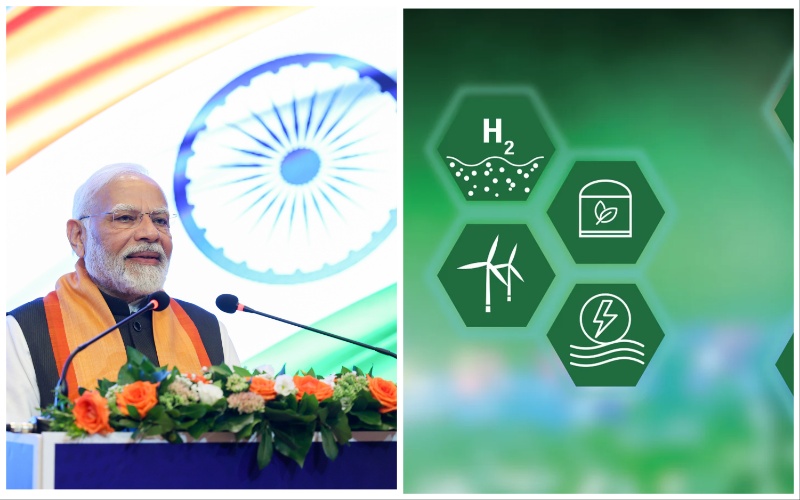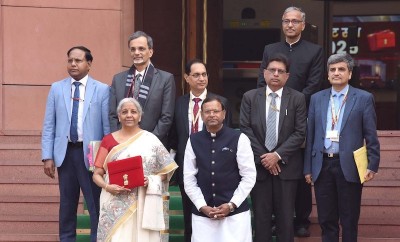 Green Hydrogen
Green Hydrogen
India: A potential hub for Green Hydrogen
The dynamic reforms and the ease of doing business will create economies of large scale and bring down the Green Hydrogen production costs among the lowest in the world.
A global demand of over 100 MMT of Green Hydrogen and its derivatives like Green Ammonia is expected to emerge by 2030 of which India can potentially export about 10 MMT of Green Hydrogen/Green Ammonia per annum which will be about 10 per cent of the global market.
India is expected to achieve Net Zero emissions by 2070.
India’s demand for energy and resources is rising each day, energy use has doubled in the last 20 years and is likely to grow by at least another 25% by 2030.
India currently imports over 40% of its primary energy requirements, worth over USD 90 billion every year.
Dependency on imported fossil fuels in the transportation and manufacturing sectors is necessitating a shift towards technologies that enable an enhanced share of renewable sources in the energy mix, and progressively reduce the dependency on fossil fuels.
Green Hydrogen has the potential to play a key role in such low-carbon and self-reliant economic progress.
Green Hydrogen can enable the utilization of domestically abundant renewable energy resources across regions, seasons, and sectors, feeding multiple usage streams, either as a fuel or as an industrial feedstock.
It can directly replace fossil fuel-derived feedstocks in petroleum refining, fertilizer production, steel manufacturing etc.
Hydrogen-fueled long-haul automobiles and marine vessels can enable the decarburization of the mobility sector.
As the global consensus towards Net Zero gathers momentum, the demand for Green Hydrogen and its derivatives is set to rise.
The asymmetries in expected demand and production capabilities for Green Hydrogen, in different countries and regions, are likely to result in international trade of Green Hydrogen and its derivatives like Green Ammonia and Green Methanol.
This presents a unique opportunity for India to capitalize on its abundant renewable energy and land resources and the growing global demand for Green Hydrogen, to become a leading producer and exporter of Green Hydrogen and its derivatives.
It is therefore an opportune moment for India to scale up Green Hydrogen production and utilization across multiple sectors and align with global trends in technology, applications, policy and regulation.
Addressing the nation on the 75th Independence Day, 15th August, 2021, Prime Minister Narendra Modi announced the National Hydrogen Mission with the aim of making India a hub for the production and export of green hydrogen.
India is at a crucial juncture in terms of its energy landscape and green hydrogen has a critical role to play to make the nation self-reliant and energy-independent.
Environmental pollution and petroleum imports are challenges in India, with a vision to make India an energy-independent nation, and to de-carbonise critical sectors, the Government announced the National Green Hydrogen Mission on January 4, 2023 with an initial outlay of ₹19,744 crore.
The Mission will facilitate demand creation, production, utilisation and export of Green Hydrogen and mobilisation of over ₹8 lakh crore of investment by 2030.
The policy takes forward the vision articulated by the Prime Minister, to make India a global hub for the production and export of Green Hydrogen.
All concerned Ministries, Departments, agencies and institutions of the Central and State Government will undertake focused and coordinated steps to ensure successful achievement of the Mission objectives.
All will support pilot projects in other hard-to-abate sectors like steel, long-range heavy-duty mobility, shipping, energy storage etc. for replacing fossil fuels and fossil fuel-based feedstocks with Green Hydrogen and its derivatives.
India’s green hydrogen policy offers many incentives for setting up a green hydrogen facility, through these measures, the government is promoting renewable energy transmission and setting up green hydrogen near the consumption sources.
These incentives include:
Ø Single-window clearance for faster project approvals
Ø Allotment of land in renewable energy parks
Ø Priority access to inter-state transmission network
Ø Open access procurement within 15 days, waiver of inter-state transmission charges
Ø A 30-day energy banking policy
The dynamic reforms and the ease of doing business will create economies of large scale and bring down the green hydrogen production costs among the lowest in the world.
A global demand of over 100 MMT of Green Hydrogen and its derivatives like Green Ammonia is expected to emerge by 2030 of which India can potentially export about 10 MMT Green Hydrogen/Green Ammonia per annum which will be about 10 per cent of the global market.
India has joined the global race to develop a green hydrogen economy to bolster its energy security.
After the release of India’s green hydrogen policy, private and state-owned companies have made a many announcements about setting up projects producing green hydrogen.
Reliance Industries Limited (RIL) is betting big on green hydrogen. The company aims to reduce the production cost of green hydrogen below US$1/kg by the end of this decade.
To meet its goal, it announced a capital outlay of Rs75, 000 crore (US$9.4 billion) over the next three years to develop manufacturing capacities for clean energy technologies, which include electrolysers to produce green hydrogen.
State-owned power generator NTPC aims to reduce production costs below US$2/kg by 2025-2026, much faster than global projections. Its bullish targets are, in fact, reflective of the Indian government’s plans for the sector.
The company is developing India’s first hydrogen-to-electricity project using US-headquartered Bloom Energy’s solid-oxide electrolysers and fuel cell technology. NTPC’s floating solar plant will power the electrolysers to produce green hydrogen.
Bloom Energy’s hydrogen fuel cell technology will convert the hydrogen into carbon-neutral electricity without combustion to power NTPC’s Guest House in Simhadri, Visakhapatnam.
In the Union Budget 2023-24, greening the economy is one of the top seven priorities (Saptarishi).
It will help in implementing many programmes for green fuel, green energy, green farming, green mobility, green buildings, and green equipment, and policies for efficient use of energy across various economic sectors.
Ethanol blending with petrol, the National Green Hydrogen mission, the promotion of electric vehicles and a tremendous push on the renewable energy front are some of the significant initiatives that India is pursuing towards a clean and green energy future.
These initiatives are playing an important role in India’s Energy transitions and to provide for large-scale green job opportunities.
In conclusion, India stands committed to reducing the emissions intensity of our GDP by 45% in 2030 and subsequently reaching net zero by 2070.
India’s commitment to a sustainable and carbon-neutral future is being guided by its enhanced National Determined Contribution (NDC) and Long-Term Low Carbon Development Strategy which call for clean and efficient energy systems, disaster-resilient infrastructure, and planned eco-restoration.
India’s net-zero goal entails a five-decade-long journey and India’s strategy is therefore evolutionary and flexible, accommodating new developments in technology.
Support Our Journalism
We cannot do without you.. your contribution supports unbiased journalism
IBNS is not driven by any ism- not wokeism, not racism, not skewed secularism, not hyper right-wing or left liberal ideals, nor by any hardline religious beliefs or hyper nationalism. We want to serve you good old objective news, as they are. We do not judge or preach. We let people decide for themselves. We only try to present factual and well-sourced news.







